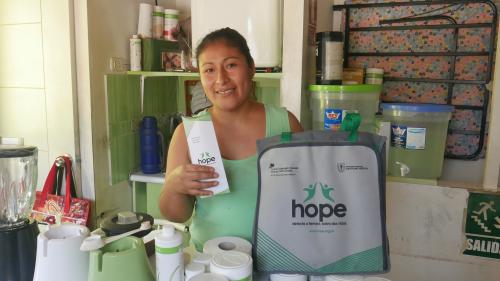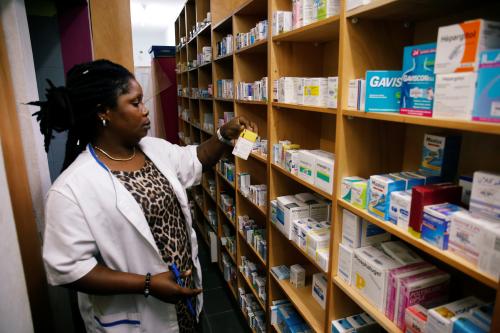Following a 2008 UN General Assembly call for human rights responsibilities from the pharmaceutical industry, low- and middle-income countries (LMICs) have benefited from an expansion of access to essential medicines. In 2015, the Sustainable Development Goals (SDGs) echoed this call in SDG Goal 3, which aims to ensure healthy lives and well-being for all people. While measurement and evaluation systems have accompanied many public-sector health programs, significant gaps remain in measuring the outcomes of private global health programs. Private-sector approaches to health care span the range from full philanthropy to for-profit commerce, and they continue to grow in size and scope. While measurement and evaluation systems have accompanied many public-sector health programs, a lot more has to be done to quantify the outcomes of private global health programs. Our understanding of the effectiveness of medications and services is limited, especially in LMICs where the outcomes are the most variable. So the impact, scalability, and sustainability of such efforts remain unclear.
With the COVID-19 pandemic absorbing large sums of public money and the attention of government providers, this gap is suddenly even more serious than it was just a few months ago. Private-sector programs frequently have resources to build infrastructure, deploy capital, and create partnerships with great potential for impact, but their take-up is often limited by the lack of tracking and reporting of standardized health outcomes and impact metrics. Proper evaluation methods and metrics aid accountability, transparency, and trust-building between providers and patients, as well as across governments, NGOs, and businesses.
Existing private measurement platforms, such as those from the Access Observatory and the Access to Medicine Foundation, play important roles to define a common lexicon for measurement of activities, though they largely remain focused on access to medicines and the pharmaceutical sector. With the recognition of the importance of patient-centeredness in all health approaches, there is strong impetus for measurement frameworks to incorporate new elements—to evaluate and strengthen the impact of all private sector initiatives so that there is increased accountability of providers to patients.
To close these gaps, we reviewed the available literature on existing programs and assessment tools, and interviewed industry leaders, researchers, government officials, and implementation partners. Our findings can be summed up in three points that relate to capacity, outcomes, and partnerships.
1. Private health programs need to increase both capacity and commitment.
One of the major deficiencies in current private-sector global health approaches is limited capacity and support for data collection and evaluation. Without good systems of data collection, data management, and analysis, the impact of these approaches is impossible to measure, and so it is difficult to improve. Money for evaluation is often seen as taking resources away from implementation. In fact, the two are clearly complementary. A recent study of 120 pharmaceutical industry-led “access to medicine” programs found that only seven had conducted evaluations, nearly all of which demonstrated low or poor quality. One of the implementation partners interviewed in our work noted that even when metrics are collected, there is a lack of basic data—such as prevalence of a disease—due to poor coordination with local governments and ministries of health.
A stronger commitment to evaluation is actually valuable to support adaptive program design and implementation, in addition to external transparency and accountability regardless of the results. For example, Novartis Access, an initiative to deliver essential medicines to LMICs at a cost of $1 per treatment per month, has distributed nearly three million monthly treatments across five countries since its launch in 2015. However, a retrospective external evaluation of this program, sponsored by Novartis, found that over the first year there was no evidence that this initiative had a substantive impact on improving access to medicine for patients in Kenya. The finding highlighted the complexity of health access, which requires an understanding not just of medication cost to be sustainable, but also patient experience, local policy, and access to general health services. Without mechanisms to evaluate the complex context of health delivery, global programs will not have visibility into factors that contribute to the success of a program or critical data to adapt programs over time.
2. Private global health programs must emphasize both impact and sustainability.
Our review of articles, reports, and scientific literature indicates that many of the indicators currently being tracked and reported by industry-supported global health programs are activity and output measures, which are the direct products of specific activities. For a hypothetical cancer-screening program, for example, an output measure may be the number of people screened. This information provides insight neither into the value of the screening activity nor the outcomes, such as the percent of people that were referred to further care from the screening activity, much less the actual improvements in individual and community health indicators.
While some progress has been made in measuring access, there is growing evidence of the need to measure quality and affordability. The Lancet Commission on High Quality Health Systems estimates that over 8 million deaths per year are attributable to poor quality health care delivery and amounts to nearly $6 trillion in economic and productivity losses, concentrated mainly in LMICs. Private global health programs can play a big role in reducing the burden of disease, but this requires a better understanding of the impact of these programs.
Private sector investments that focus on quality lead to greater impact than programs that address only cost alleviation for medications. Relatedly, programs that emphasize impact-driven long-term partnerships can substantially improve health outcomes. Merck & Co. launched Merck for Mothers, a $500 million 10-year commitment to reducing maternal mortality in LMICs through partnerships and program support. This program focuses on implementing and scaling innovative solutions such as their Push Model in Senegal, which is recognized as best practice for supply-chain building. Merck for Mothers currently operates over 50 programs in over 30 countries, with more than 100 implementation partners. Importantly, this program also invested in a long-term collaboration with the London School of Hygiene and Tropical Medicine as the principal evidence-generation partner. As Peter Piot, director of the London School, says, “It’s worth noting how unusual yet refreshing it is for a donor—especially a corporate one—to put their investments under the microscope.”
3. Cross-sector and pre-competitive partnerships are underappreciated and underutilized.
Stronger partnerships among firms within an industry as well as across sectors provide opportunities to combine services and capabilities to design and implement patient-centered, sustainable, and scalable solutions. Without increased collaboration, there is not only duplication of efforts, but also a clear dilution of impact that any individual program can have. Kenya, for example, has one of the largest numbers of private-sector initiatives, many of which have the same goals and even similar local partners. Of the 129 private-sector cancer-care initiatives reported to the Access to Medicine Foundation, 19 operate in Kenya, the highest number in any LMIC, with the majority of these initiatives supporting capacity-building activities. This potential for redundancy and unnecessary competition can be seen in access programs across disease states, contributing to wasted financial investments and fragmented efforts by local organizations. Focusing instead on pre-competitive opportunities for co-investment and collaboration is more likely to lead to improved outcomes.
The urgency of the COVID-19 global pandemic has further highlighted the need as well as potential for greater public-private and private-private collaboration. The National Institutes of Health (NIH), in concert with private enterprises, recognized this need and launched the ACTIV partnership, an unprecedented collaboration between leading pharmaceutical companies and health agencies to accelerate the development of COVID-19 treatments and vaccines. While this novel collaboration may speed up research and product development in the short term, it is critical to study these initiatives so these partnerships do not dissolve after this pandemic, and also to strengthen similar collaborations to address access, affordability, and quality of essential health technologies and services.
Our research reveals the need to strengthen impact metrics and collaborative partnerships among health care providers, advocacy groups, and private enterprises. The best way to do this might actually be to foster partnerships that prioritize impact evaluation. Given the growing health care needs and the shrinking fiscal envelopes of governments all over the world, learning more about which private-sector programs work well is no longer just another option, it is a necessity.
Disclosures: The following organizations have provided research and operational support (funding and/or in-kind) through Duke University or Duke-affiliated non-profit, Innovations in Healthcare, in the past 12 months: Amgen, Asia Pacific Medical Technology Association, AstraZeneca, Bayer, Bill and Melinda Gates Foundation, Commonwealth Fund, Duke Corporate Education, Grand Challenges Canada, McKinsey & Company, Pfizer, Pfizer Foundation, Takeda, USAID, Vynamic, World Economic Forum.













Commentary
Extending the reach of private health initiatives beyond the pill
June 30, 2020